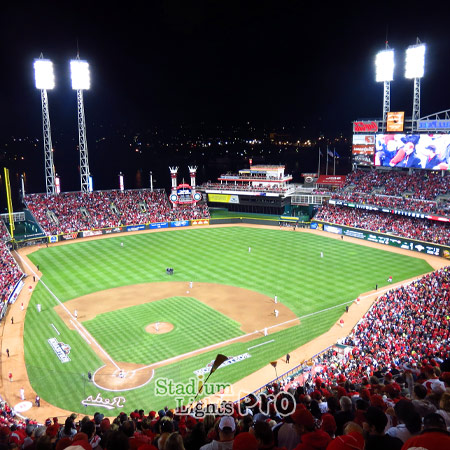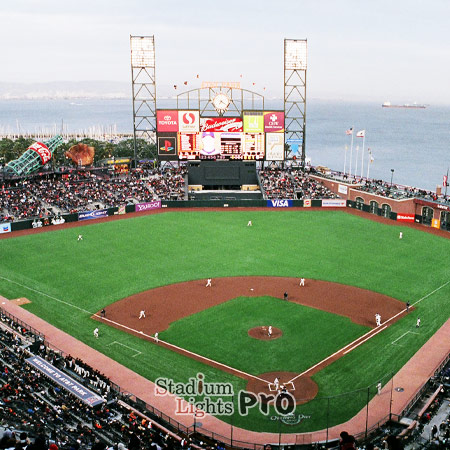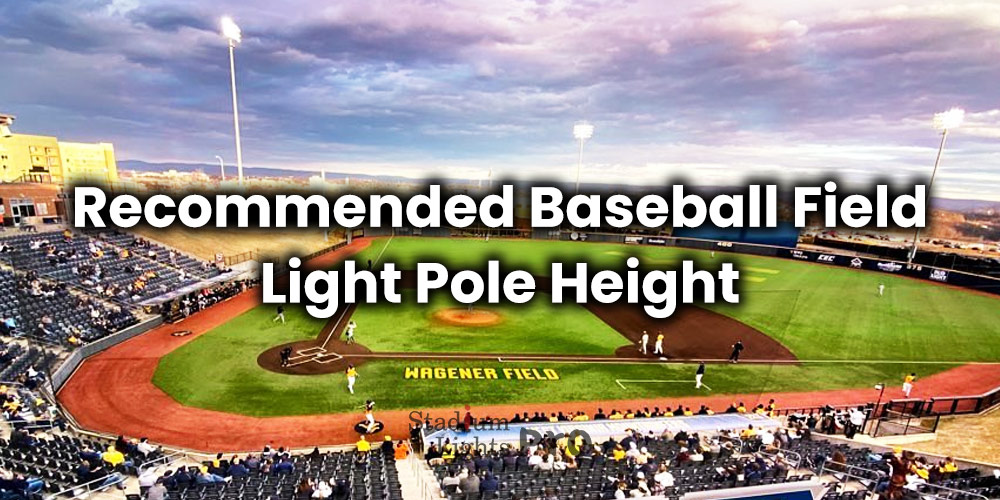Baseball field lighting plays a crucial role in enabling games to be played during evening hours and ensuring optimal visibility for players, officials, and spectators. Proper lighting allows for improved gameplay, enhances safety, and provides an enjoyable experience for everyone involved.
Table of Contents
ToggleImportance of proper light pole height
The height of light poles in a baseball field is a critical factor in achieving effective and efficient lighting. It directly impacts the distribution and intensity of light across the playing surface. Proper light pole height ensures that the field is adequately illuminated, minimizing shadows, glare, and uneven lighting that can hinder gameplay, compromise player safety, and diminish the overall experience.
Best light pole height for different baseball fields
Baseball field lighting requires careful consideration of the optimal light pole height to ensure proper visibility and safety for players, as well as an enjoyable experience for spectators. Different types of baseball fields, such as Little League and youth fields, high school and college fields, and professional fields, have specific recommendations and industry standards for light pole height.
| Level of competition | Baseball field light pole height |
| Little League | 20 to 30 ft |
| High school or college | 30 to 50 ft |
| Professional (e.g. MLB) | 70 to 100 ft |
 For Little League and youth baseball fields, the recommended light pole height typically ranges from 20 to 30 feet. This lower height ensures that the playing surface is well-illuminated, allowing young players to see the ball clearly and react effectively. It also minimizes shadows and glare that can hinder visibility and impact player safety. Choosing a height appropriate for the average height of the players avoids obstruction of sightlines.
For Little League and youth baseball fields, the recommended light pole height typically ranges from 20 to 30 feet. This lower height ensures that the playing surface is well-illuminated, allowing young players to see the ball clearly and react effectively. It also minimizes shadows and glare that can hinder visibility and impact player safety. Choosing a height appropriate for the average height of the players avoids obstruction of sightlines.
In high school and college baseball fields, taller light poles are necessary due to the larger playing areas. The optimal light pole height for these fields generally falls between 30 to 50 feet, depending on the field dimensions and lighting standards. The higher poles ensure adequate illumination of the entire playing surface, allowing players to track the ball accurately and make quick decisions. Uniform lighting without excessive shadows or dark spots enhances visibility, improving gameplay and reducing the risk of collisions or injuries. Careful consideration is needed to avoid obstructing views for both infielders and outfielders.
Professional baseball fields adhere to industry standards set by organizations like Major League Baseball (MLB) and the American National Standards Institute (ANSI). The recommended light pole height for professional fields typically ranges from 70 to 100 feet, depending on the field size and lighting requirements. These higher poles are necessary to accommodate broadcast requirements and provide optimal visibility for players. It is essential to minimize shadows, glare, and uneven lighting that can impact player performance. Balancing player needs with the spectator experience is crucial, ensuring clear views of the field without obstruction.
Light pole height and shadowing
Effects of shadows on gameplay and safety
 Shadows on a baseball field can have significant impacts on gameplay and safety. When players or objects cast shadows on the field, it can make it difficult for players to track the ball accurately, affecting their ability to make precise catches, throws, or hit the ball. Shadows can also create visual distractions and hinder depth perception, leading to errors or misjudgments.
Shadows on a baseball field can have significant impacts on gameplay and safety. When players or objects cast shadows on the field, it can make it difficult for players to track the ball accurately, affecting their ability to make precise catches, throws, or hit the ball. Shadows can also create visual distractions and hinder depth perception, leading to errors or misjudgments.
Moreover, shadows can pose safety risks for players. A sudden change in lighting conditions caused by shadows can make it challenging for players to see and react to potential hazards on the field, such as other players or equipment. This increases the likelihood of collisions or injuries.
Mitigating shadowing with proper light pole height
One effective way to mitigate shadows on a baseball field is by selecting the appropriate light pole height. By positioning the light poles at an optimal height, it becomes possible to minimize the casting of shadows on the playing surface. The goal is to achieve uniform illumination across the entire field, reducing the presence of shadows that could interfere with gameplay and player safety.
Proper light pole height ensures that light is directed in a way that minimizes the creation of shadows. By strategically placing the light poles and adjusting their height, it becomes possible to achieve a more evenly lit field, improving visibility and reducing the impact of shadows on players’ performance and safety.
Shadow-free lighting solutions
Aside from proper light pole height, there are other lighting solutions available to minimize shadows and provide shadow-free illumination on baseball fields:
- Directional lighting – Utilizing lighting fixtures with adjustable angles allows for precise aiming of light beams. By directing light where it is needed most, shadows can be minimized.
- Overhead lighting – Placing lights directly above the playing surface can reduce shadows by illuminating the field from multiple angles and minimizing obstructions that cast shadows.
- Supplemental lighting – Adding additional light fixtures or towers strategically can help fill in areas that may be more prone to shadows, ensuring a more uniform and shadow-free lighting distribution.
- Advanced lighting technologies – Advancements in lighting technology, such as LED lighting systems, offer improved control over light direction and intensity, enabling better shadow mitigation and customization of lighting conditions on the field.
By combining the appropriate light pole height with these shadow-free lighting solutions, baseball fields can achieve optimal illumination, enhancing gameplay, improving player safety, and providing an optimal experience for both players and spectators.
Lighting regulations and standards
Overview of relevant lighting guidelines and codes
When it comes to baseball field lighting, there are several lighting guidelines and codes that provide recommendations and requirements for proper illumination. These guidelines are established to ensure consistent lighting quality, safety, and fair play across different baseball fields. Some of the relevant guidelines and codes include:
- American National Standards Institute (ANSI) Standards – ANSI publishes standards related to sports lighting, including ANSI/IES RP-6-15, which provides lighting recommendations for outdoor sports, including baseball fields.
- Little League Baseball Lighting Guidelines – Little League Baseball has its own lighting guidelines that provide recommendations for light levels, uniformity, and glare control for various levels of play.
- High School Athletic Associations – State high school athletic associations often have specific lighting requirements for baseball fields that member schools must adhere to for official competitions.
- Professional Baseball Leagues – Professional baseball leagues, such as Major League Baseball (MLB), have their own lighting standards that ensure optimal visibility for players and meet the broadcasting requirements of televised games.
Importance of adhering to regulations
Adhering to lighting regulations is essential for several reasons:
Consistency and fair play
Following lighting regulations ensures that all teams and players have a level playing field with consistent lighting conditions, minimizing any advantage or disadvantage that may arise from variations in lighting.
Player safety
Regulations often include guidelines for minimizing glare, shadowing, and other potential hazards that could impact player safety. Adhering to these regulations helps create a safer playing environment and reduces the risk of injuries.
Compliance with local laws
Many jurisdictions have specific regulations or codes governing outdoor lighting installations. Adhering to these regulations is necessary to comply with local laws and ensure that lighting installations are safe and in accordance with community standards.
Avoiding penalties and fines
Non-compliance with lighting regulations may result in penalties, fines, or even the suspension of games or events. Adhering to the regulations helps avoid these consequences and maintains a positive relationship with governing bodies and local authorities.
Considerations for light pole height installation
Structural requirements and engineering considerations
When determining the light pole height for a baseball field, it is crucial to consider the structural requirements and engineering considerations to ensure the stability and safety of the lighting system. Some key factors to consider include:
Load-bearing capacity
Light poles need to be designed to withstand the weight of the lighting fixtures, as well as potential wind loads and other forces acting on them. The structural engineer should determine the appropriate load-bearing capacity based on the specific lighting system and environmental conditions.
Foundation design
The foundation for the light poles must be carefully designed to provide sufficient stability and support. Factors such as soil conditions, local building codes, and the height of the light poles will influence the foundation design.
Structural integrity
The materials and construction methods used for the light poles must meet structural integrity standards. This ensures that the poles can withstand external forces, such as wind or impact, without compromising their stability or safety.
Environmental factors and wind load
Environmental factors, especially wind load, play a significant role in determining the appropriate light pole height. Some considerations include:
Wind load analysis
The wind load on the baseball field light poles must be analyzed to ensure that they can withstand the anticipated wind forces in the area. Factors such as the location of the field, wind speeds, and topography are taken into account in this analysis.
Aerodynamic design
Light pole design should consider aerodynamic factors to reduce wind resistance and minimize the impact of wind on the stability of the poles.
Wind region codes
Local building codes may specify wind region classifications and provide guidelines for light pole design based on these classifications. Adhering to these codes ensures that the lighting system can withstand the wind conditions in the region.
Cost implications and maintenance considerations
Determining the baseball field light pole height also involves considering cost implications and maintenance considerations.
Cost of installation
Taller light poles generally require more materials and additional installation efforts, which can impact the overall cost of the lighting system. The cost implications of the light pole height should be evaluated in relation to the available budget.
Maintenance accessibility
The maintenance of the lighting system should be taken into account when determining the light pole height. Light fixtures at greater heights may require specialized equipment or increased safety measures for maintenance and repairs.
Lifespan and durability
The materials and design of the light poles should be chosen with durability in mind. Opting for high-quality materials and appropriate corrosion-resistant coatings can contribute to a longer lifespan and reduced maintenance needs.
Energy efficiency
While not directly related to light pole height, considering energy-efficient lighting options can help reduce long-term operational costs. LED lighting, for example, offers energy efficiency and lower maintenance requirements compared to traditional lighting technologies.
Factors influencing light pole height
Several factors influence the determination of light pole height for baseball fields. Understanding these factors helps in determining the appropriate height for optimal lighting performance.
Field size and dimensions
The size and dimensions of the baseball field play a significant role in determining the ideal light pole height. Larger fields may require taller light poles to ensure adequate coverage and uniform lighting throughout the playing area.
Level of play
The level of play is another crucial factor in determining light pole height. Different levels of baseball, such as amateur, high school, college, and professional, may have specific lighting standards and regulations that prescribe recommended pole heights to meet the specific requirements and standards of each level.
Lighting standards and regulations
There are lighting standards and regulations set by organizations and governing bodies, such as the American National Standards Institute (ANSI) and sports associations like Little League, high school athletic associations, and professional baseball leagues. These standards may provide guidelines and specifications for light pole height to ensure consistent lighting quality across different baseball fields.
Shadowing and light distribution
The prevention of shadows and ensuring uniform light distribution are critical considerations for determining the appropriate light pole height. Properly positioned and sufficiently tall light poles help minimize shadows cast by players and other objects on the field, creating a well-lit playing surface that maximizes visibility and safety.
Conclusion
Selecting the optimal light pole height for baseball field lighting is crucial for ensuring player safety, enhancing gameplay, and creating an enjoyable experience for spectators. By considering factors such as player visibility, structural requirements, wind load, and cost implications, successful implementations can be achieved. Adhering to relevant lighting guidelines and codes, learning from past challenges, and leveraging technological advancements contribute to the development of efficient and effective lighting systems. Ultimately, finding the right balance between functionality, safety, and aesthetics helps create a well-illuminated baseball field that meets the needs of players, spectators, and the overall game experience.
We invite you to contact us for more information and take advantage of our offer for a free baseball field lighting design. Our team of experts will work closely with you to assess your specific needs and requirements. Through our comprehensive design process, we will consider various factors such as field dimensions, player safety, visibility, and aesthetics to determine the most suitable light pole height for your baseball field.
By availing our free baseball field lighting design, you will gain valuable insights and recommendations tailored to your unique circumstances. Our team will take into account industry standards, local regulations, and the latest advancements in lighting technology to provide you with a detailed plan that maximizes the performance, safety, and enjoyment of your baseball facility.
Don’t hesitate to reach out to us and take the first step towards achieving optimal lighting for your baseball field. Contact us today to schedule a consultation and receive your personalized lighting design proposal.

